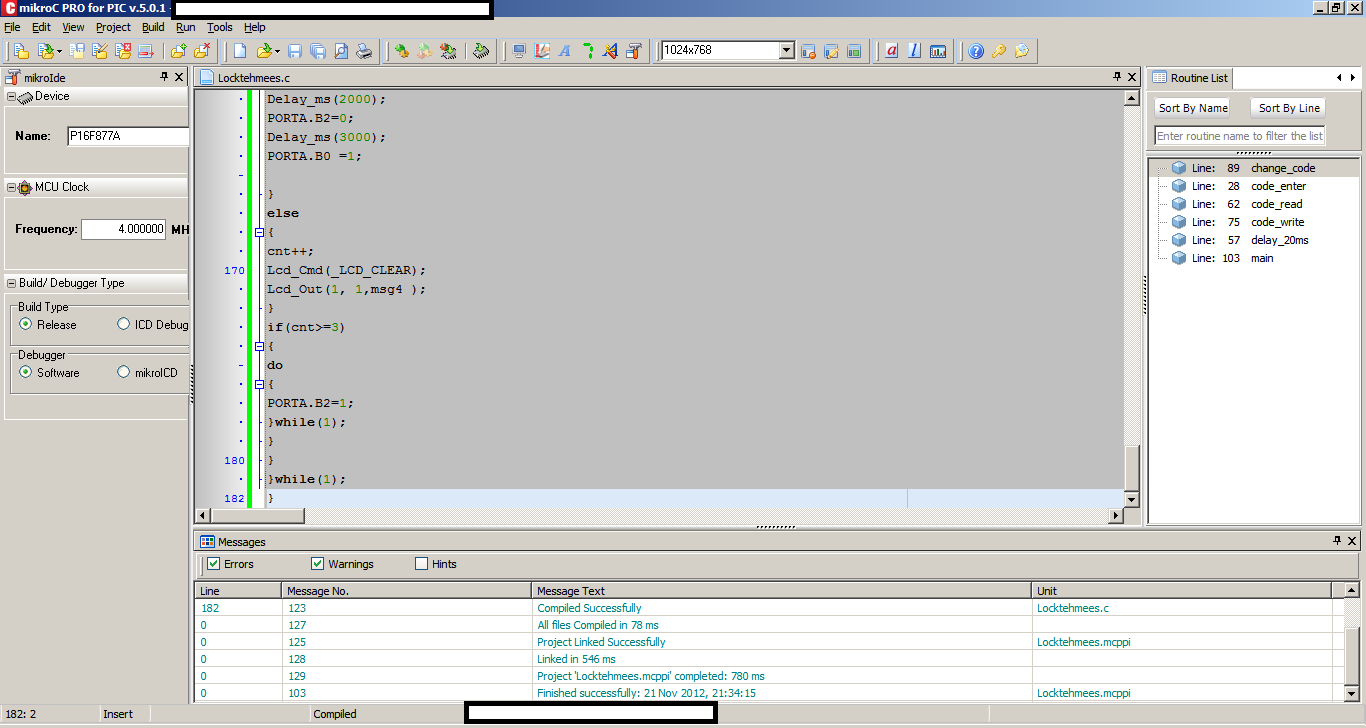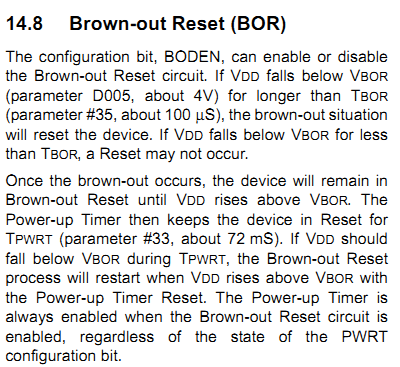tehmaas hasan
Junior Member level 1
HELP REQUIRED THIS IS THE CODE OF ELECTRONIC LOCK. I CANNOT COMPILE IT ON MIKROC BECAUSE THEre IS MISSING LIBRARY FILE OF KEYPAD SINCE I HAVE NOTE MADE THIS CODE MY SELF I DONT KNOW ITS PROPER LIBRARY FILE.
PLEASE PROVIDE ME ITS LIBRARY FILE(ALL NECESSARY FILES). I WANT TO COMPILE IT AND I REALLY NEED ITS HEX FILE PLEASE HELP ME AS SOON AS POSSIBLE.
PLEASE PROVIDE ME ITS LIBRARY FILE(ALL NECESSARY FILES). I WANT TO COMPILE IT AND I REALLY NEED ITS HEX FILE PLEASE HELP ME AS SOON AS POSSIBLE.
Code:
unsigned short kp;
char code1[10] ,user1[4];
char msg1[20] = "Initializing......",msg2[12] = "Enter Code";
char msg3[15] = "Access Granted",msg4[15] = "Access Denied";
char msg5[15] = "Enter New Code";
int i=0,j,cnt;
// Keypad module connections
char keypadPort at PORTD;
// End Keypad module connections
// LCD module connections
sbit LCD_RS at RB2_bit;
sbit LCD_EN at RB3_bit;
sbit LCD_D4 at RB4_bit;
sbit LCD_D5 at RB5_bit;
sbit LCD_D6 at RB6_bit;
sbit LCD_D7 at RB7_bit;
sbit LCD_RS_Direction at TRISB2_bit;
sbit LCD_EN_Direction at TRISB3_bit;
sbit LCD_D4_Direction at TRISB4_bit;
sbit LCD_D5_Direction at TRISB5_bit;
sbit LCD_D6_Direction at TRISB6_bit;
sbit LCD_D7_Direction at TRISB7_bit;
// End LCD module connection
void code_enter()
{
kp = 0; // Reset key code variable
// Wait for key to be pressed and released
do
//kp = Keypad_Key_Press(); // Store key code in kp variable
kp = Keypad_Key_Click(); // Store key code in kp variable
while (!kp);
// Prepare value for output, transform key to it's ASCII value
switch (kp)
{
case 1: kp = '1'; break; // 1
case 2: kp = '2'; break; // 2
case 3: kp = '3'; break; // 3
case 5: kp = '4'; break; // 4
case 6: kp = '5'; break; // 5
case 7: kp = '6'; break; // 6
case 9: kp = '7'; break; // 7
case 10: kp = '8'; break; // 8
case 11: kp = '9'; break; // 9
case 13: kp = 42; break; // *
case 14: kp = 48; break; // 0
case 15: kp = 35; break; // #
}
code1[i] = kp;
Lcd_Chr(2, i+1, code1[i]); // Print key ASCII value on Lcd
i++;
}
void delay_20ms()
{
Delay_ms(20);
}
void code_read() //Wead data from EEPROM
{
delay_20ms();
user1[0] = EEPROM_Read(0x00); // Read data from address 0
delay_20ms();
user1[1] = EEPROM_Read(0x01); // Read data from address 2
delay_20ms();
user1[2] = EEPROM_Read(0x02); // Read data from address 4
delay_20ms();
user1[3] = EEPROM_Read(0x03); // Read data from address 8
delay_20ms();
}
void code_write() //Write data from EEPROM
{
delay_20ms();
EEPROM_Write(0x00,code1[0]); // Write some data at address 00
delay_20ms();
EEPROM_Write(0x01,code1[1]); // Write some data at address 02
delay_20ms();
EEPROM_Write(0x02,code1[2]); // Write some data at address 04
delay_20ms();
EEPROM_Write(0x03,code1[3]); // Write some data at address 08
}
void change_code()
{
Lcd_Cmd(_LCD_CLEAR); // Clear display
Lcd_Out(1, 1, "Enter New Code");
i=0;
code_enter();
code_enter();
code_enter();
code_enter();
code_write();
code_read();
}
void main()
{
ADCON1 |= 0x07; // Configure AN pins as digital
TRISA = 0x00; // set direction to be output
PORTA.B0 =1;
Keypad_Init(); // Initialize Keypad
Lcd_Init(); // Initialize Lcd
code_read();
//If no code is stored then default is 2345
if(user1[0] == 0xFF && user1[1] == 0xFF && user1[2] == 0xFF && user1[3] == 0xFF )
{
EEPROM_Write(0x00,'2'); // Write some data at address 00
delay_20ms();
EEPROM_Write(0x01,'3'); // Write some data at address 02
delay_20ms();
EEPROM_Write(0x02,'4'); // Write some data at address 04
delay_20ms();
EEPROM_Write(0x03,'5'); // Write some data at address 08
}
code_read();
Lcd_Cmd(_LCD_CLEAR); // Clear display
Lcd_Cmd(_LCD_CURSOR_OFF); // Cursor off
Lcd_Out(1, 1,msg1 );
Delay_ms(500);
Lcd_Cmd(_LCD_CLEAR);
// Clear display
cnt=0;
do
{
Lcd_Cmd(_LCD_CLEAR);
Lcd_Out(2, 3, "Press *");
i = 0;
code_enter();
if(code1[0] == 42)
{
Lcd_Cmd(_LCD_CLEAR); // Clear display
Lcd_Out(1, 1,msg2);
//delay_ms(500);
i = 0;
code_enter();
code_enter();
code_enter();
code_enter();
code_enter();
if(code1[0] == '2' && code1[1] == '3' && code1[2] == '4' && code1[3] == '5' && code1[4] == '5') //check master code
{
code_enter();
if(code1[5] == 35)
{
change_code();
}
}
if(cnt<3 && code1[0] == user1[0] && code1[1] == user1[1] && code1[2] == user1[2] && code1[3] == user1[3] && code1[4] == 35) //compare code with store one
{
Lcd_Cmd(_LCD_CLEAR); // Clear display
Lcd_Out(1, 1, msg3);
PORTA.B0 =0;
PORTA.B2=1; //Buzzer
Delay_ms(2000);
PORTA.B2=0;
Delay_ms(3000);
PORTA.B0 =1;
}
else
{
cnt++;
Lcd_Cmd(_LCD_CLEAR);
Lcd_Out(1, 1,msg4 );
}
if(cnt>=3)
{
do
{
PORTA.B2=1;
}while(1);
}
}
}while(1);
}
Last edited by a moderator:

